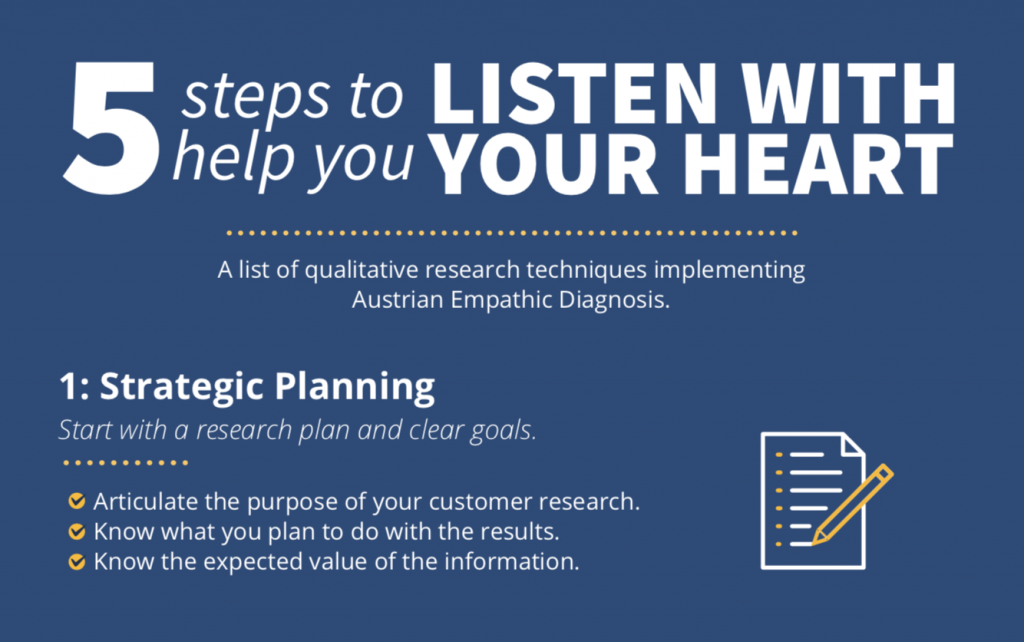33. Isabel Aneyba: Listening From the Heart and the Techniques of Empathy
Per Bylund teaches us to explore the only two fields that matter for entrepreneurial success: understanding the laws of economics and understanding the mind of the customer. Isabel Aneyba is an expert in the techniques of empathic diagnosis that yield the understanding of the customer’s mind, and she shares these techniques — and her success in starting and growing a customer research company — on the Economics For Entrepreneurs podcast.
Key Takeaways and Actionable Insights
Listening to customers is a planned activity. Yes, we suggest regular, frequent, conversational interaction with customers. But not without a calculated purpose. You need to know in advance what you will do with the information — what decisions will you make that you can’t make now. This enables you to define the expected value of the information, and how much of your scarce resources of time and money to allocate to gathering and processing it. If you don’t know the purpose and estimated value of the research, don’t conduct it.
Conduct conversations with customers at least every week. Isabel includes conversations in the customers’ homes or offices, conversations in your offices, face-to-face (including digital face-to-face using webcams). To make emotional connections, we look into each others’ eyes. Certainly, these conversations can be integrated with findings from other customer data sources, but they can’t be replaced.
Exercise your passion for listening; don’t focus on asking questions. The style of conversational research is the opposite of interrogation. Don’t work too hard on composing a list of questions, and sticking to your list. Once the conversation starts, let it flow. Focus on what the customer is thinking and feeling, not on facts. Use non-verbal cues to do so (Isabel tells us how during the podcast). Employ gentle probes (“Tell me more about that”) rather than direct questions. Let the customer do the talking and make it comfortable and easy for them. Good researchers, and all entrepreneurs, have a passion for listening.
Storytelling is the great revealer. Rather than ask a structured set of questions about, for example, the stages of a customer journey, it’s better to get the customer to tell a story, in their own words. Invite them to start at the beginning and continue to the end, without interruption. For example, the story of a visit to the doctor might begin with feeling symptoms and end with the doctor’s prescription. The customer will tell you everything that went on in between, from the drive to the office to the time in the waiting room to the doctor’s demeanor. Let them tell the story uninterrupted. You can loop back later into internal details.
Try other exercises besides asking questions. In some cases, Isabel favors the exercise of having a customer make a collage out of photos, magazine pages and other materials. The choices in the collage can revel preferences, and the customer is naturally open to explaining why they made the choices and what the collage and its elements means to them.
Listen with the heart to uncover hidden truths. Isabel explains how:
- Open the conversation with an “emotional handshake”. Find a conversational path (which might not concern your business question) for the customer to express emotion. “What do you love to do?”
- Listen for the customer’s emotional drivers — expressions like “I feel” or “I enjoy” — when they talk about a behavior or choice or a functional benefit. These expressions reveal emotions, and you can gently probe whether these emotions represent the subjective reason why customers behave as they do.
- Interpretation is required — the customer won’t tell you that they take action X because of emotional driver Y. You have to make the connection. Then gently probe to see if you can find confirmation.
Apply the learning to design a better customer experience. Remember that customer research has a purpose. Your purpose in business is to create and keep a customer. Customers purchase your good and services for the experience they anticipate. By listening for their emotional drivers, you’ll identify gaps in the current experience — examples of customer unease. Use the information you gather to eliminate the gaps, and relieve the unease.
Compute the return on information. How much does the information gathering cost? How much value will you able to facilitate for the customer by designing an experience they feel better about?
Free Downloads & Additional Resources
“5 Steps To Help You Listen With Your Heart” (PDF): Click to Download
Isabel Aneyba’s company, COMARKA Consulting & Marketing Research
“Qual Method Aims to Unite Clients, Respondents in Co-creation”








Leave a Reply
Want to join the discussion?Feel free to contribute!